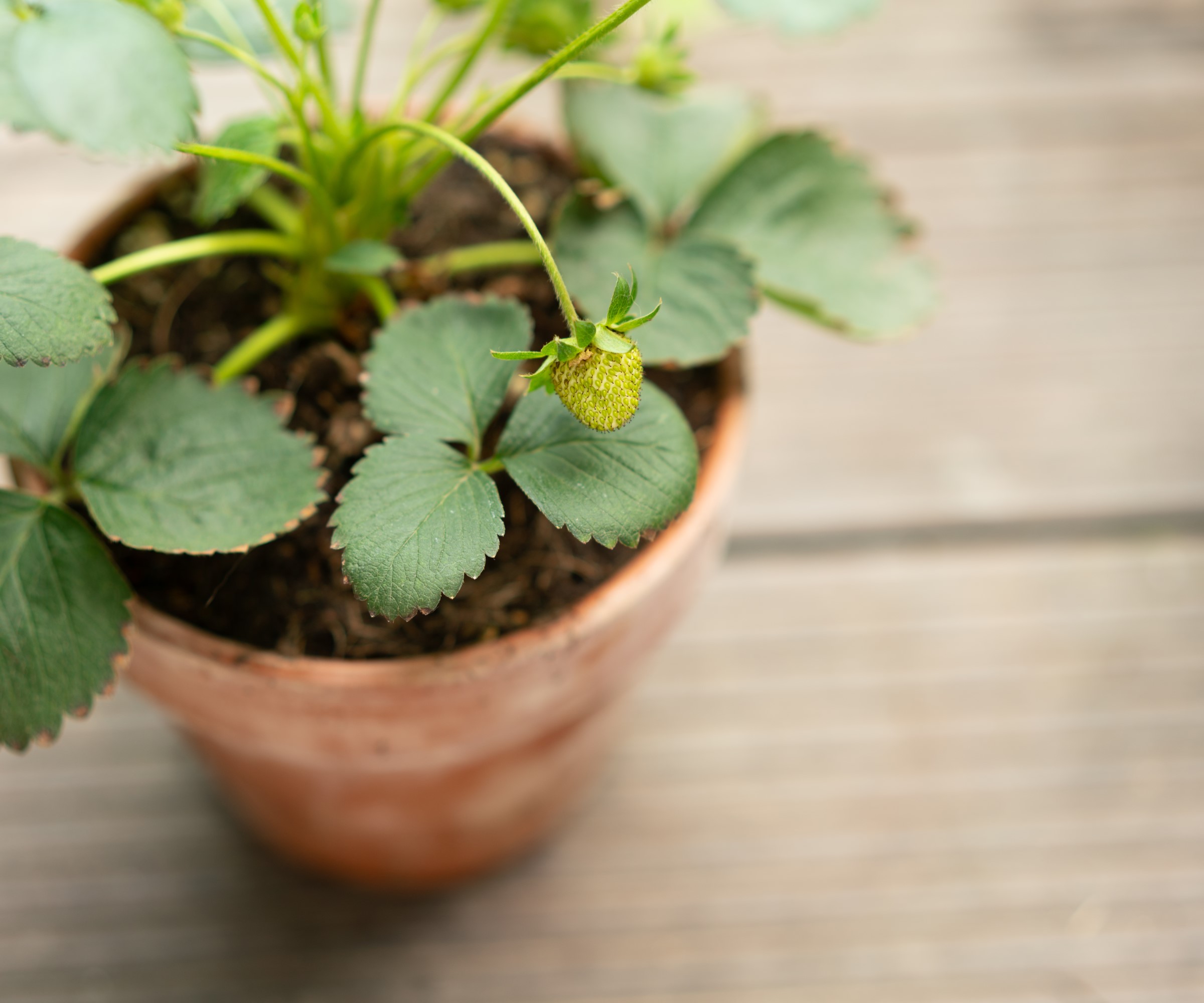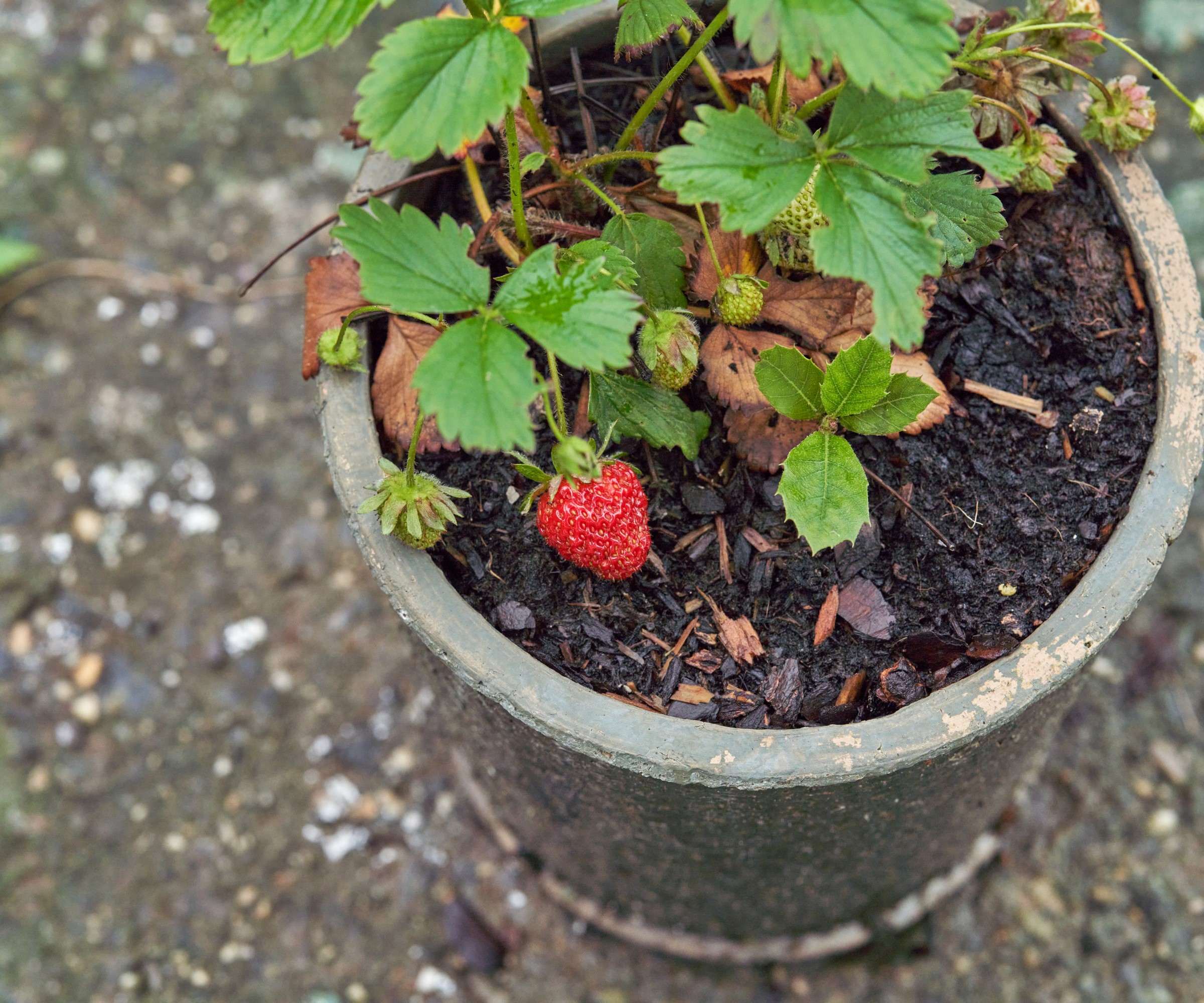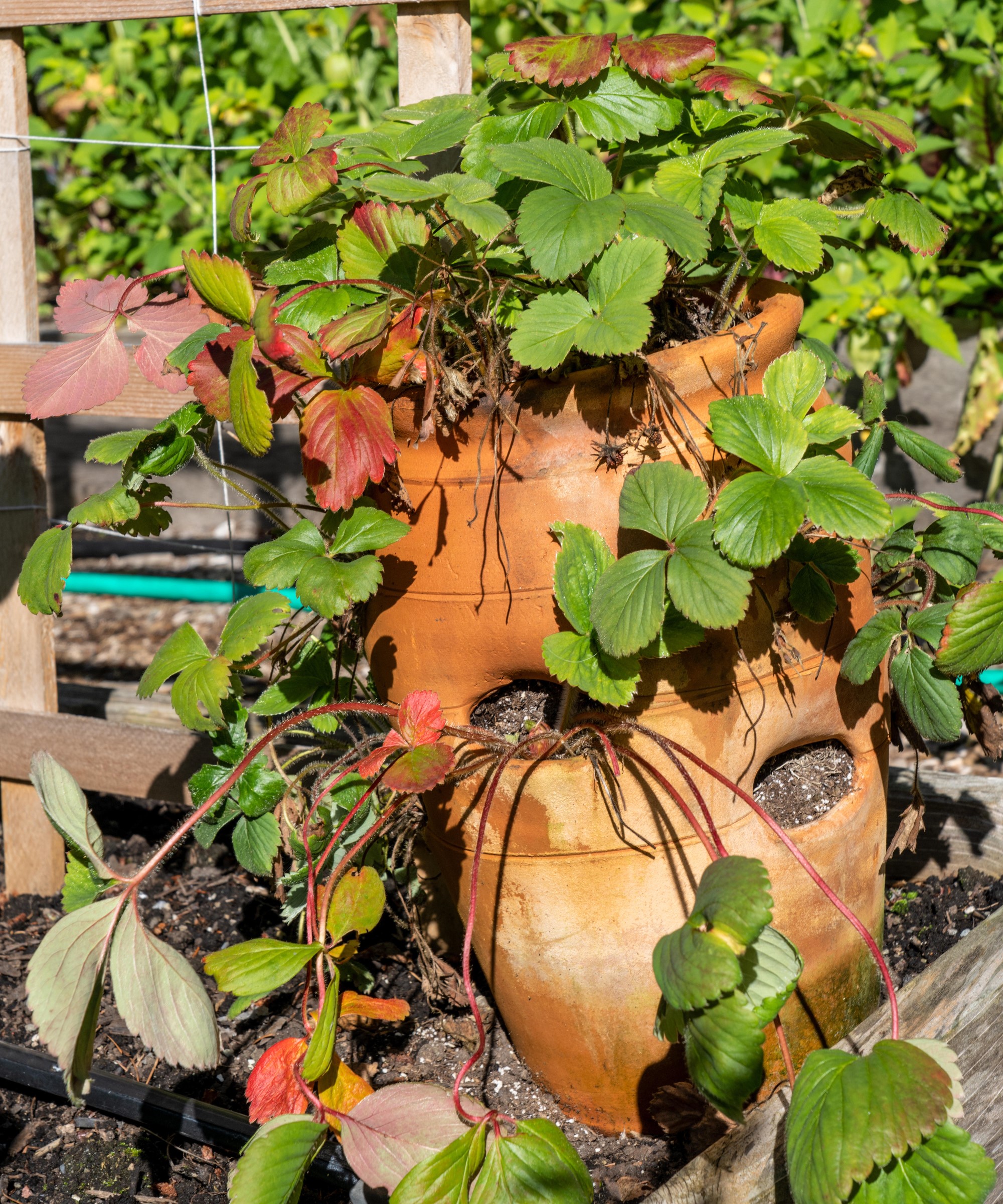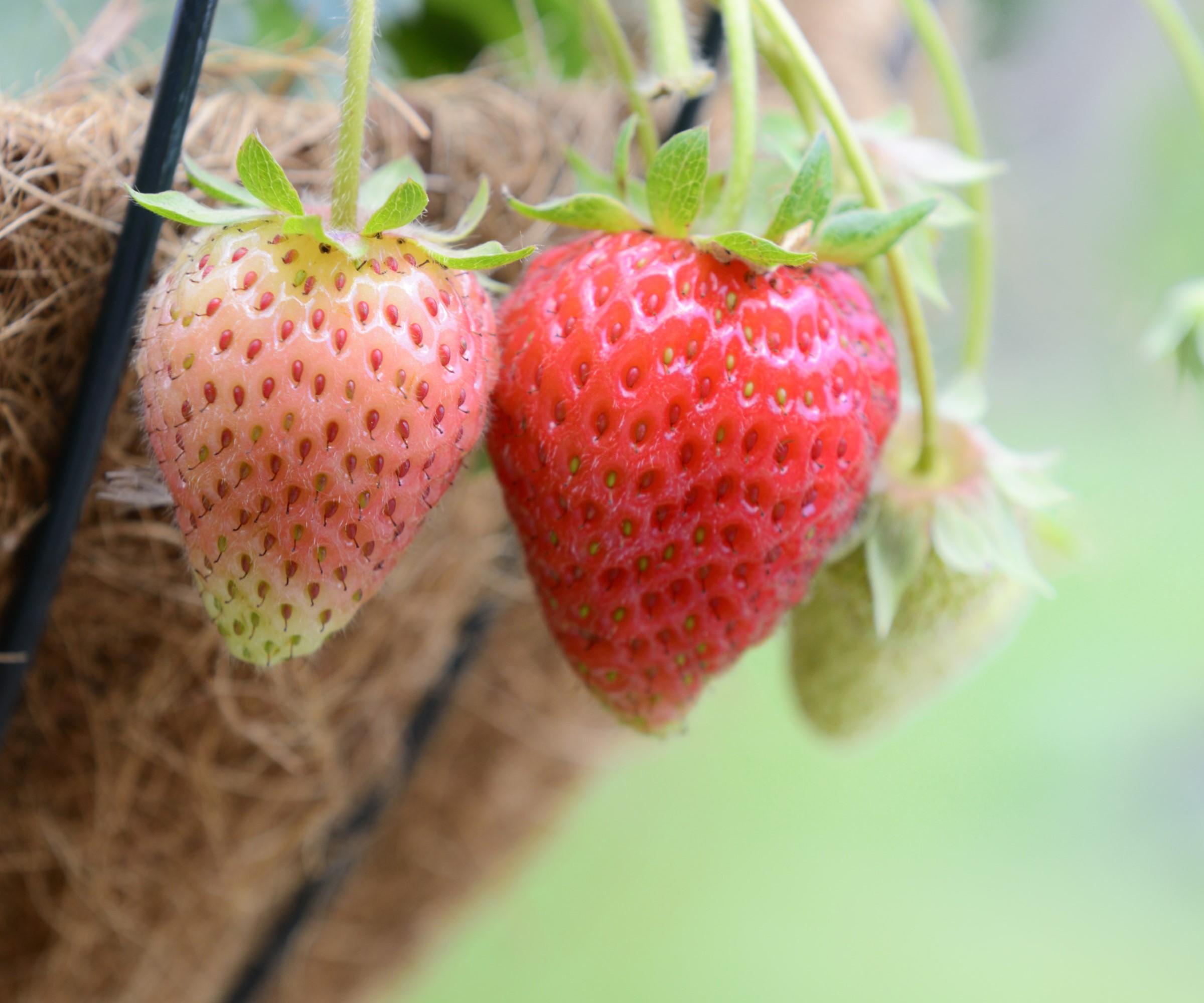How to grow strawberries in pots and hanging baskets – expert tips for homegrown fruit
Discover how to plant and grow strawberries in a container or hanging basket

- Can you grow strawberries in a pot?
- Benefits of growing strawberries in containers
- Choosing a container
- How many plants can you have in a pot?
- How to plant strawberries in containers
- How to plant a strawberry pot
- How to grow strawberries in hanging baskets
- How to care for strawberry plants in pots
- FAQs

Growing strawberries in pots is a simple way to get delicious homegrown fruit all summer long. Any variety of strawberry can be grown in pots and there is a wide range of containers to choose from.
Strawberries can be grown in pots, planters, strawberry pots, buckets, or even hanging baskets – there is a container suitable for any situation. Plant your container up, keep an eye on watering and feeding, and you can enjoy this perfect summer fruit.
It is easy to learn how to grow strawberries in containers and in no time you can be sampling homegrown strawberries in your desserts, in a cold glass of fizz, or just enjoying a fruit fresh from the plant out in the backyard.

Pots for growing strawberries can come in various materials

Drew is a former professional gardener in the UK who worked in productive kitchen gardens growing fruit, vegetables, and herbs for chefs. He has grown, maintained, and harvested many different varieties of strawberries. These were both grown in the ground outdoors and indoors in raised containers.
Can you grow strawberries in a pot?
The short answer is yes. Any type of strawberry plant can be grown in a pot and give you a bounty of summer fruits. You can get strawberry plants in a variety of ways, either growing your own or buying young plants. Plants can be bought in pots from a store or are often delivered bare root from retailers in spring, both are ready to plant immediately into your chosen pot. Strawberry plants can also be grown from seed or from runners taken from existing plants, though plants from seed will fruit in their second year.
- Buy bare root strawberry plants from Walmart
- Buy bare root strawberry plants from Burpee
- Buy bare root strawberry plants from Nature Hills
Benefits of growing strawberries in containers
There are real advantages to growing strawberries in pots or containers. It allows anyone the opportunity for homegrown fruit, including if they have a really small backyard or even have no access to open ground in a backyard – as strawberries can be grown on a patio or as part of a balcony garden.
Strawberries are one of the best container gardening ideas as you can control the soil they are being grown in, move the pots to find the best conditions for growing your crop, and raise the fruits above ground level away from being nibbled by slugs or snails.

Pots should be a minimum 12 inches diameter
Choosing a container for strawberries
There is a wide variety of potential containers to grow strawberries in, including the likes of terracotta or plastic pots, planters, hanging baskets, grow bags, or the classic strawberry planting pots. If you want a big crop then it may be necessary to use several pots or planters. Strawberry plants normally want to be spaced around 14-16 inches apart, however in containers they can be grouped a bit closer together at around 10-12 inches apart. Any pot or container for strawberry plants needs to be at least 12 inches deep.
Design expertise in your inbox – from inspiring decorating ideas and beautiful celebrity homes to practical gardening advice and shopping round-ups.
There are many factors to consider when choosing your container. For example, terracotta pots will dry out faster than their plastic or glazed counterparts and pots at ground level will need raising up to keep fruit away from slugs – an issue that doesn’t affect them if you're planting in a hanging basket.
An additional consideration for pot size is the fact that smaller pots and hanging baskets only have a small amount of compost, so will need more regular watering and feeding. Ensuring any pot has drainage is vital as a lack of drainage holes in a pot is a common container gardening mistake and one that can lead plants to rot.
How many plants can you have in a pot?
It is normal practice for a 12-14 inch diameter pot or hanging basket to be big enough for two or three strawberry plants. However, Bob Flowerdew, gardening expert for Homes & Gardens, advocates that ‘bigger is better’ when it comes to growing strawberries in containers. He recommends growing strawberries in old buckets, claiming you can get ‘massive crops’ using that method.
‘Many folk get miserable crops because their plants dry out and starve when growing in a modicum of compost in containers that are too small,’ he says. ‘One common mistake people make with strawberries is expecting them to succeed in too small a container. This not only restricts cropping but also makes watering difficult, as smaller pots dry out quickly and become hard to re-wet.
‘I’ve found that one plant in an old bucket (with drainage holes made) is perfect, giving plenty of room for the roots and thus superb crops.’

Having the fruit raised off the ground protects it from being nibbled by unwanted pests
How to plant strawberries in containers
Knowing when to plant strawberries is a key part in getting healthy plants that provide you with a bumper crop of fruit. Strawberries tend to be planted in fall or spring outdoors, that remains the norm even if the crop is being grown in pots. Strawberries planted in containers in fall should be kept in a frost-free place to over-winter.
Fill the pot with a good quality multi-purpose compost to within an inch of the rim of the container and incorporate a handful of slow-release general fertilizer. Plant each strawberry so that the crown of the plant, where the leaves come out from, is sitting just above the surface of the soil. Water the pot well and place it in a spot that gets full sun, ideally where the plants can get between six and eight hours of sunlight each day.
How to plant a strawberry pot
Strawberries have traditionally been planted into strawberry pots, a name given to a unique terracotta pot with both an area for planting on the top – like a traditional pot – and opening around the sides of the pot too. The strawberry plants are both planted into the soil on the top and also pressed into the side holes too. It allows more plants to grow in one container and also makes it one of the more unique vegetable garden container ideas as the strawberries tumble down the sides of the pot, making a fantastic feature. You can see a large terracotta strawberry pot available at Amazon.
When growing strawberries in such strawberry pots, Christine Walden, expert for Amateur Gardening, advises a method of how to make sure the plants all down the pot can be watered and fed efficiently and those in the planting pockets do not dry out.
‘Drill holes in a piece of plastic pipe and sit the pipe in the middle of the container from top to bottom,’ she recommends. ‘Fill the pipe with grit. Next, fill in the empty space around the pipe with compost and incorporate a slow-release fertilizer into the compost mix. Then plant the strawberries through the openings in the sides of the pot. Watering and feeding will take place via the pipe.’

Strawberry pots have planting holes around the sides and make a unique feature
How to grow strawberries in hanging baskets
Hanging baskets allow you to grow strawberries in small spaces and away from any animals or pests that could nibble on your fruits before you have got to them. Planting a hanging basket involves using traditionally wire or woven containers that are lined with either plastic, coir, or sphagnum moss.
A container should be at least 12 inches wide and 12-15 inches deep – which is enough space for three or four strawberry plants. Space the plants around the edge of the basket and water well after planting.
Hang the basket from sturdy supports in a sunny spot and in a spot near to spring flowers that will attract pollinating insects to help set the fruit. Any variety of strawberry can succeed in a hanging basket, however it is common for gardeners to select trailing varieties for hanging baskets that put on a wonderful display as they cascade over the edge of the basket.

Tumbling varieties of strawberry work great in hanging baskets
How to care for strawberry plants in pots
Strawberries grown in containers will need regular watering and fertilizing. It is important to check the soil for when to water plants at least every few days and make sure to use your fingers to see the moisture levels around an inch or two deep into the soil. The soil wants to be moist, but not waterlogged, and containers will dry out much quicker than when growing strawberries in the ground.
The choice of pot will also dictate how often you water, with porous terracotta pots drying out faster. During periods of hot weather, it is likely to require daily watering. When watering your strawberry plants, try to avoid wetting the leaves as this can increase the risk of fungal disease.
Knowing when to fertilize strawberries is also very important when growing the fruit in containers. Any new plants going into pots should be fed with a general fertilizer at the time of planting, this will help encourage the growth of strong roots. John Thomas, owner of Backyard Garden Geek, also recommends incorporating mature compost into the soil for newly-planted strawberries.
‘After your plants begin fruiting, you can apply a fertilizer with slightly higher potassium content to promote the growth of new shoots and runners as well as a more robust root system. You can also add some bone meal to the soil at this time since it's a great organic way to give your plants some additional phosphorus,’ adds John.
When the first flowers appear, a high-potassium fertilizer – such as a tomato feed – is ideal to feed the plants every week or two. At the end of the season, in the fall, give the plants a feed with a balanced fertilizer to encourage strong growth and a good crop next year.

Pick strawberries regularly throughout the summer to encourage more to ripen
FAQs
Can you leave strawberries in pots over winter?
If you are wondering how to winterize strawberry plants in containers, then there are options to choose from. While the plants are hardy, they can benefit from being protected by being moved indoors into a covered area or by mulching around the base. The plants should be cut back after fruiting, cleared of old foliage, and allowed to go dormant.
In very cold areas they should be moved to a protected area, such as an unheated garage or shed – the dormant plants do not need light in winter – or pots can be sunk into the ground with only the rim sitting above the soil.
A covering with a type of mulch, such as straw, can protect the crown from freezing temperatures. If you do not bury the container itself, then insulate the sides of any pot with a mulch to protect the plant’s roots. It should be noted that terracotta pots are more at risk of cracking due to the cold than plastic ones.
Are strawberries better in pots or ground?
Strawberries grow successfully both in the ground and in containers – there are pros and cons to both methods of growing strawberries. For example, if you grow strawberries in pots then you can have full control over the soil and the conditions, and you can reduce the likelihood of pests nibbling on the fruits before you get to pick strawberries. On the other hand, strawberry plants tend to have a shorter lifespan in pots compared to ones grown in the ground.
How many years will strawberry plants produce for?
Strawberry plants are perennials but will need replacing about every three years. After this point in their life they tend to reduce in vigor and your harvest will decrease as a result. The plants will send out runners each year, and it can be a very simple process to grow new plants from these runners.
Strawberries are really simple to grow in pots and open up opportunities for anyone to enjoy growing this delicious summer crop. Any container that is sizable enough can be used to grow strawberries, providing it has drainage holes. So it opens up the chance to be creative and create a really unique strawberry planter that not only looks fantastic but also is bountiful with delicious fruits.

Drew has worked as a writer since 2008 and was also a professional gardener for many years. As a trained horticulturist, he worked in prestigious historic gardens, including Hanbury Hall and the world-famous Hidcote Manor Garden. He also spent time as a specialist kitchen gardener at Soho Farmhouse and Netherby Hall, where he grew vegetables, fruit, herbs, and cut flowers for restaurants. Drew has written for numerous print and online publications and is an allotment holder and garden blogger. He is shortlisted for the Digital Gardening Writer of the Year at the 2025 Garden Media Guild Awards.